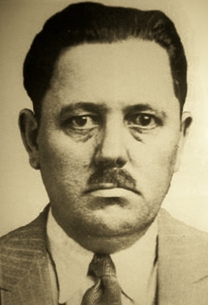Fred Burke (Fred Burke)

Criminal. One of eight children of Mr. and Mrs. Wall Camp of Mapleton, Kansas. Teachers of Fred Burke stated he attended school in which he was exceedingly intelligent. He also attended Sunday school regularly. His real name was Thomas Camp. At seventeen he was involved in a land-fraud scheme with a traveling salesman. He fled the area to avoid prosecution and became involved with criminal enterprises around Kansas City, Missouri. It was during this time he is believed to have changed his name from Thomas Camp to Fred Burke. Fred Burke had migrated to St. Louis, Missouri by 1915 where he became a member of the city’s top gang, Egan’s Rats. In these early years his criminal activity was mostly devoid of the violence that so permeated his life in the 1920s and early 1930s. Burke, described as tall, well-built, and honest-looking, acted as a “front man” for the Egan gang in various forgery and fraud schemes. In 1917 after being indicted in St. Louis for forgery, Fred decided to join the army, America had recently entered into World War I and Fred served as a tank sergeant in France. By 1922, Burke was back with Egan’s Rats and working with a crew of three fellow war vets in various robberies around the Gateway City, including a “take” of $80,000 dollars from a St. Louis distillery. In June 1925, the City of St. Louis police dept. arrested Fred Burke along with his brothers in arms Gus Winkeler and Milford Jones. All were found to be carrying an arsenal of weapons. After being chased by police, the gangsters threw weapons out the windows of their vehicles.One Smith and Wesson revolver, .38 Caliber fully loaded, Two .45 Caliber Automatics and in a leather handbag they found a fully loaded Waffenbrak Mauser .30 Caliber (German machinegun). Fred was a traveling bankrobber and hitman who would do anything if the price was right. Killers to many, but to Winkeler, Harvey Baily and other gangsters, he was a friend. Their reputation preceding them, Burke’s crew were eagerly welcomed by Al Capone, who referred to them as his “American Boys”. Working out of Chicago, Fred Burke and his cohorts were involved in a series of murders and armed robberies as far east at Brooklyn, New York and Patterson, New Jersey and as far south as Louisville, Kentucky. Among them was the murder of a police officer in Toledo, Ohio following a bank robbery in 1928. It would not be Burke’s last “cop killing.” In 1928 and early 1929 Al Capone had a problem in the name of Bugs Moran and his Irish gang from Chicago’s Northside. Fred Burke and his crew of killers were his problem-solver. Five members and two associates of the Moran gang were lured to a garage on Clark street in Chicago. Burke and company burst into the meeting, some dressed as police, and executed the Moran faction. The shocking event received international press attention and within a few weeks Fred Burke was named by Chicago police as a principal suspect in the murders. Bullets fired from Burke’s confiscated machinegun matched perfectly with slugs removed from Frankie Yale’s body. Following the St. Valentine’s Day massacre, Fred Burke continued his pattern of armed robberies and the occasional murder. The beginning of the end happened however in December 1929. An intoxicated and paranoid Burke, using the alias Fred Dane, was involved in a minor traffic accident in St. Joseph, Michigan. When Patrolman Charles Skalay (sometimes mistakenly identified as Skelly) arrived at the wreck scene he was shot and killed by Burke. Fred Burke died in prison in 1940. (bio by: Shock) Cause of death: Heart attack.
Born
- May, 28, 1893
- USA
- Mapleton, Kansas
Died
- July, 07, 1940
- USA
- Marquette Michigan,
Cause of Death
- Heart attack
Cemetery
- Marquette State Penitentiary
- Marquette, Michigan
- USA



